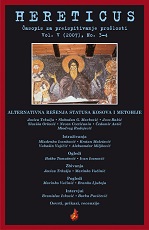Kuda ide Srbija
Where is Serbia Headed?
Author(s): Krstan MaleševićSubject(s): Politics / Political Sciences
Published by: Centar za unapređivanje pravnih studija
Keywords: democracy; transformation; reforms; future; Serbia
Summary/Abstract: Since the dramatic social changes of October 2000 there is widely expressed commitment to democratisation and reform in Serbia. However despite this nominal commitment to change both - everyday experience and the available empirical research - indicate that the State of Serbia and the Serbian society as a whole have not yet embarked on the substantial democratic reconstruction. Instead Serbia finds itself again, as many times in its history, on the gigantic crossroads which are perhaps even more dramatic than the one taken on the 5 October 2000: where to go from here? There are two clearly demarcated roads: one headed towards preservation and renewal of pre-modern, patriarchal, clerical and xenophobic Serbia and the other towards genuine and speedy (post)modernisation. This dilemma is made even more dramatic by the lack of clear developmental strategy of the democratic transformation of Serbia and by the increasing strength of the retrograde tendencies. The clear synthetic expression of the present condition is the very fact that Serbia is constantly and ever more lagging behind the developed world, and that for the first time in its modern history the children of Serbia are worse off than their parents! The results of last, January 2007, elections clearly demonstrate that there is no reform oriented stable democratic majority capable of "pushing" Serbia forward. This change obviously cannot be expected from the Serbian Radical Party and the Socialist Party whose pre October 2000 policies have already significantly dented Serbia's development. Neither can one hope for substantive change from the national-democrats and populists (so-called people's coalition) that openly flirt with the socialists and the radicals and with whose help notorious heiress of Party of Serbian Unity officially became a member of "the democratic block". With the strength of these political forces one can witness a revival of the party-state whereby the political parties have near absolute monopoly of the state apparatus leading towards some form of "semi-feudal governance" within the confines of political parties. In such circumstances the extreme political forces can easily acquire mass support and in this process marginalise or even proscribe those forces that support speedy democratic modernisation. It is also highly likely that the unresolved problem of the status of Kosovo will reduce the chances for further democratic development or perhaps even reverse the existing modest achievements. Taking all of this into account it is apparent that if Serbia wishes to become a developed, democratic, civic, attractive and normal European state it requires the most difficult and the most complex reforms in this history.
Journal: HERETICUS - Časopis za preispitivanje prošlosti
- Issue Year: 2007
- Issue No: 3-4
- Page Range: 102-133
- Page Count: 32
- Language: Serbian

